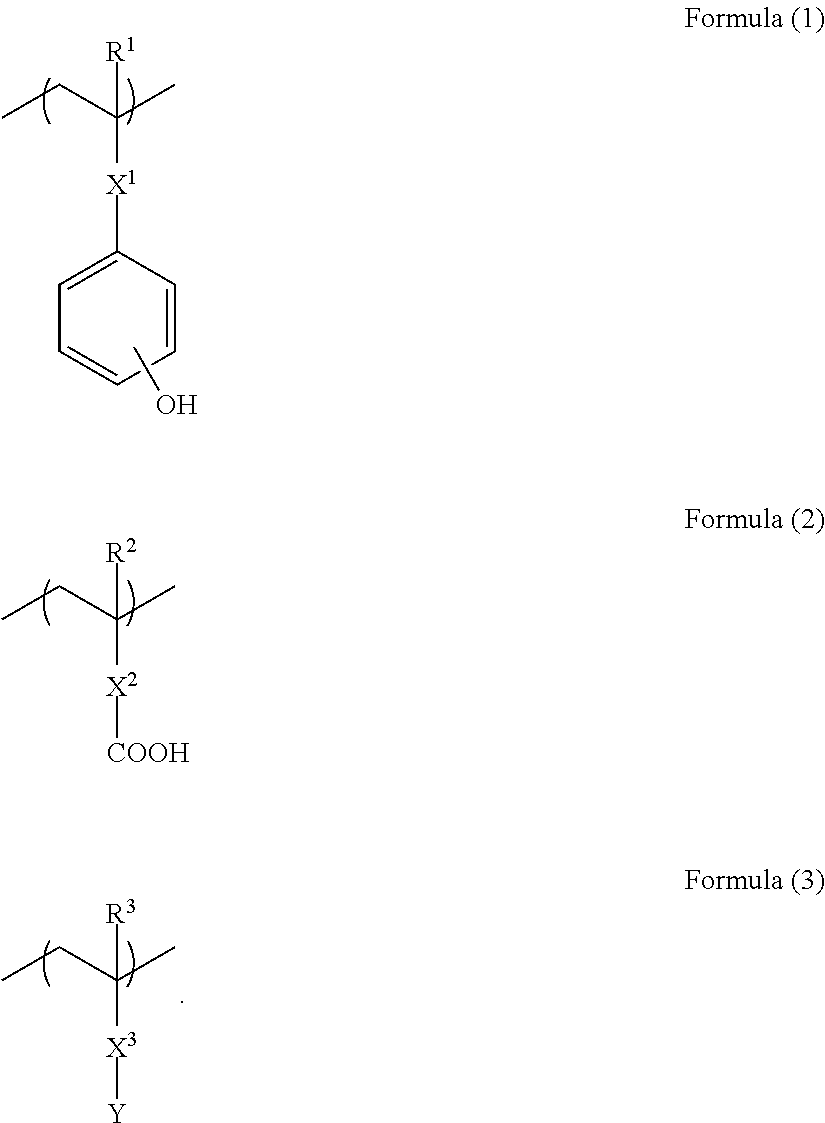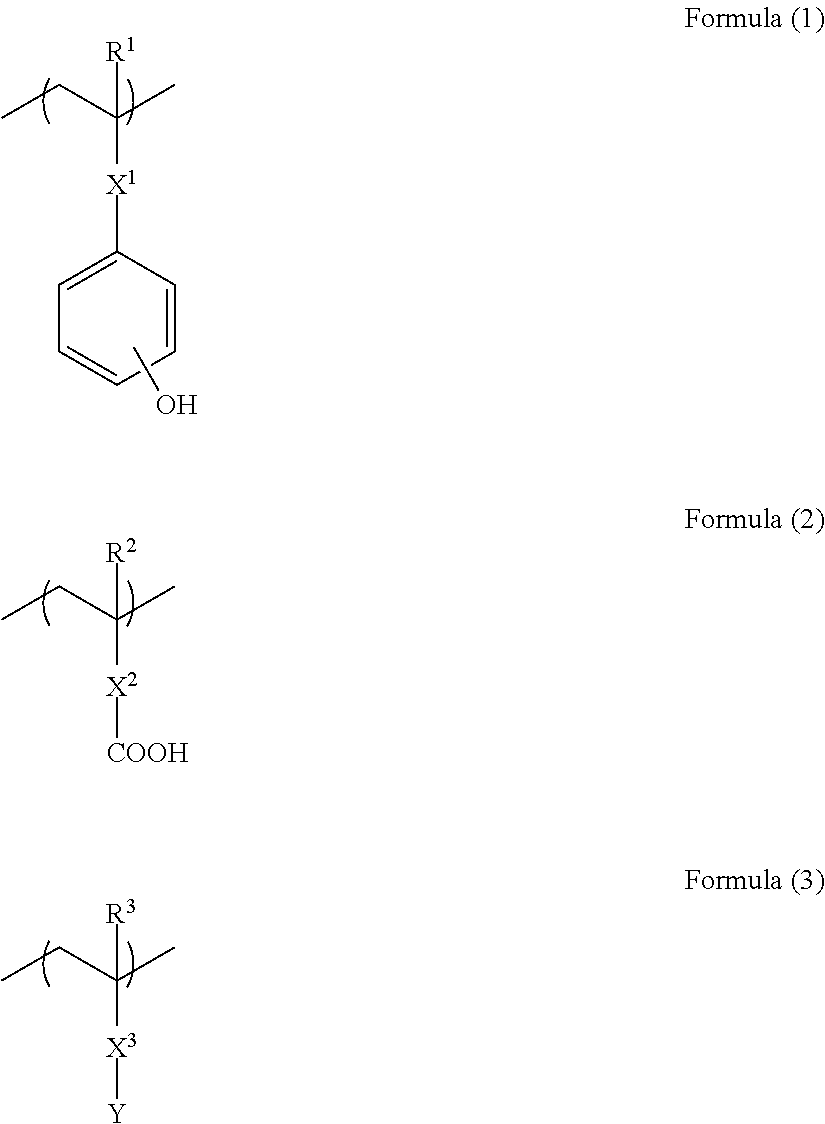Photosensitive resist underlayer film forming composition
a resist film and resist technology, applied in the field of resist underlayer film, can solve the problems of lowering the dimensional accuracy of the photoresist pattern, difficult to keep the film thickness of the resist large enough for the processing of the substrate, and performing dry etching, etc., to achieve the effect of shortening the diffusion length of the strong acid
- Summary
- Abstract
- Description
- Claims
- Application Information
AI Technical Summary
Benefits of technology
Problems solved by technology
Method used
Image
Examples
example
Synthesis Example 1
[0089]20 g of N-(4-hydroxyphenyl)methacrylamide (manufactured by Tokyo Chemical Industry Co., Ltd.), 11.148 g of 4-vinylbenzoic acid (manufactured by Tokyo Chemical Industry Co., Ltd.), 17.327 g of 9-anthracenemethyl methacrylate (manufactured by Osaka Organic Chemical Industry Ltd.), and 4.8 g of 2,2′-azobis(isobutyric acid)dimethyl (manufactured by Wako Pure Chemical Industries, Ltd.) were dissolved in 124.4 g of methanol. The resultant reaction solution was dropped into 90 g of methanol warmed to 70° C. over 10 hours. Then, while maintaining the resultant reaction mixture at 70° C., the reaction was effected for 12 hours. The resultant reaction mixture was charged into ethyl acetate to precipitate a polymer. The obtained powder polymer was dried under reduced pressure to produce 42.5 g of a polymer of Formula (8-1):
[0090]
The obtained polymer was subjected to a GPC analysis and as the result of the analysis, the polymer was found to have a weight average molecul...
synthesis example 2
[0091]20 g of 4-acetoxystyrene (manufactured by Tosoh Corporation), 4.55 g of methacrylic acid, and 2.46 g of 2,2′-azobis(isobutyric acid)dimethyl (manufactured by Wako Pure Chemical Industries, Ltd.) were dissolved in 63 g of tetrahydrofuran. The resultant reaction solution was dropped into 45 g of tetrahydrofuran warmed to 70° C. over, 10 hours. Then, while maintaining the resultant reaction mixture at 70° C., the reaction was effected for 12 hours. The resultant reaction mixture was charged into hexane to precipitate a polymer. Next, 10 g of the obtained polymer and 3 g of triethylamine were dissolved in 3 g of water, 30 g of methanol, and 30 g of tetrahydrofuran, and the resultant reaction solution was heated to reflux for 14 hours, followed by returning the reaction solution to room temperature to concentrate the reaction solution. Then, the resultant reaction mixture was re-dissolved in 30 g of acetone, to which 3 g of acetic acid was added. Next, the resultant reaction soluti...
example 1
[0093]0.1 g of the polymer obtained in Synthesis Example 1 as (A) was mixed with 0.04 g of 1,3,5-tris(4-vinyloxybutyl)trimellitate (Formula (4-2)) as (B), 0.0058 g of triphenylsulfonium triflate (manufactured by Midori Kagaku. Co., Ltd.; trade name: TPS-105; Formula (8-3) below) as (C), 0.0038 g of N-lauryldiethanolamine (manufactured by Tokyo Chemical Industry Co., Ltd.) as (F), and 0.0098 g of triphenylsulfonium pentadecafluorooctanoate (manufactured by Wako Pure Chemical Industries, Ltd.; trade name: WPAG-422; Formula (8-4) below) as (1)), and the resultant mixture was dissolved in 8.9 g of propylene glycol monomethyl ether as (E). Subsequently, the resultant solution was filtered using a polyethylene microfilter having a pore diameter of 0.10 μm, and further filtered using a polyethylene microfilter having a pore diameter of 0.05 μm to prepare a photosensitive resist underlayer film forming composition (solution).
[0094]
PUM
| Property | Measurement | Unit |
|---|---|---|
| wavelength | aaaaa | aaaaa |
| wavelength | aaaaa | aaaaa |
| pore diameter | aaaaa | aaaaa |
Abstract
Description
Claims
Application Information
 Login to view more
Login to view more - R&D Engineer
- R&D Manager
- IP Professional
- Industry Leading Data Capabilities
- Powerful AI technology
- Patent DNA Extraction
Browse by: Latest US Patents, China's latest patents, Technical Efficacy Thesaurus, Application Domain, Technology Topic.
© 2024 PatSnap. All rights reserved.Legal|Privacy policy|Modern Slavery Act Transparency Statement|Sitemap



